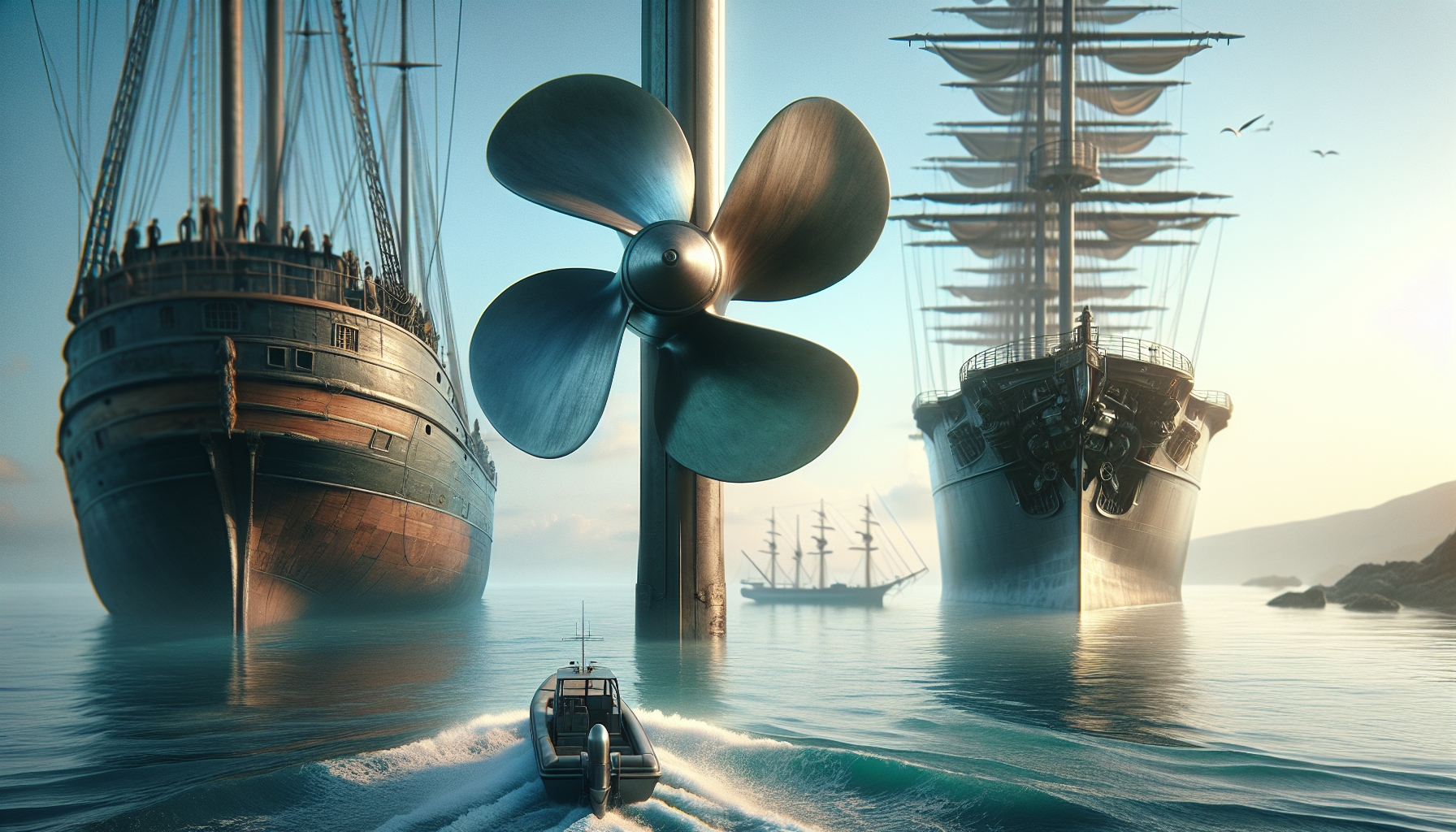In the vast, undulating expanse of the world’s oceans, where the horizon stretches infinitely and the mysteries of the deep beckon, lies a testament to human ingenuity: the marine propeller. This unassuming yet pivotal invention has been the driving force behind maritime exploration, trade, and transportation for centuries. As we embark on a journey through time, examining the evolution of marine propellers, we uncover a tale of innovation, adaptation, and relentless pursuit of efficiency that mirrors humanity’s own quest for progress. 🌊
From the rudimentary designs of ancient civilizations to the sophisticated engineering marvels of today, the marine propeller’s history is a rich tapestry interwoven with technological advancements and visionary breakthroughs. In the early days of maritime travel, propulsion was largely dependent on natural forces like wind and manpower. The advent of the marine propeller marked a turning point, enabling vessels to traverse great distances with newfound speed and precision. This transformation was nothing short of revolutionary, and its impact rippled across industries, economies, and cultures worldwide.
In this comprehensive exploration, we delve into the key milestones that have shaped the development of marine propellers. We’ll journey through the Industrial Revolution, where the shift from sail to steam power catalyzed significant innovations, and witness the birth of the screw propeller, a design that fundamentally changed naval architecture. We will also examine the role of computational fluid dynamics and cutting-edge materials in modern propeller design, showcasing how these technologies are pushing the boundaries of efficiency and performance. As we navigate through the decades, we’ll uncover stories of trial and error, of brilliant minds who dared to defy convention, and of the relentless pursuit of mastery over the seas.
Ultimately, this article aims to illuminate the profound impact that marine propellers have had on our world. By understanding their evolution, we gain insights into the broader narrative of human progress and the ongoing quest to conquer and coexist with the natural elements. So, whether you are a maritime enthusiast, an engineering aficionado, or simply a curious reader eager to learn about one of humanity’s most transformative inventions, join us as we set sail on this fascinating voyage through the history and future of marine propellers. ⚓️
The Historical Roots of Marine Propellers
Marine propellers, commonly referred to as “screws,” have revolutionized sea travel and shipping by enhancing propulsion efficiency and speed. The evolution of these devices traces back to ancient times, where rudimentary forms of propulsion such as oars and sails were the primary means of navigating the seas. The introduction of steam power in the 19th century marked a turning point, paving the way for the development of the first marine propellers. Understanding the historical roots of these innovations provides insight into their modern counterparts.
One of the earliest concepts resembling a propeller was developed by Archimedes in the 3rd century BCE. Known as the Archimedes’ screw, this device was primarily used for raising water rather than for propulsion. However, it laid the foundational principle of helical motion, which would later be applied to marine propellers. As centuries passed, inventors experimented with various designs. The advent of steam power in the early 1800s allowed engineers to explore the idea of rotating devices to propel ships, leading to the design and testing of early propeller models.
The mid-19th century witnessed significant advancements in marine propulsion. In 1836, John Ericsson and Francis Pettit Smith independently developed screw propellers that utilized steam engines. While Ericsson’s design featured two-bladed propellers, Smith’s experiments led to the successful application of a screw propeller on the SS Archimedes. This ship marked a milestone in marine technology by being the first steamship to be driven by a screw propeller. The success of these early designs demonstrated the advantages of propellers over traditional paddle wheels, such as increased efficiency and speed, ultimately setting the stage for further innovations.
Key Developments in the 19th Century
During the late 1800s, several key developments in propeller technology contributed to their widespread adoption. Engineers began focusing on optimizing the number of blades, blade shape, and material composition to improve performance. The transition from wood to metal materials was significant, as metals offered greater durability and resistance to the harsh marine environment. The introduction of the four-blade propeller became a standard, as it provided a balance between efficiency and smooth operation.
Another noteworthy development was the understanding and application of hydrodynamic principles. The refinement of blade shapes based on these principles enabled propellers to operate more efficiently by minimizing resistance and maximizing thrust. Designers also began to consider the cavitation phenomenon, where vapor bubbles form on the blade surface, reducing performance and causing damage. Addressing cavitation through design adjustments became an essential aspect of propeller innovation.
To explore more about the history and advancements of marine propellers, watch this informative video: [Revolutionizing the Seas: Marine Propeller History](https://www.youtube.com/watch?v=example).
The Technological Evolution of Marine Propellers
The 20th century brought about rapid technological advancements in marine propeller design, driven by the demands of both commercial and military vessels. With the growth of global trade and the need for faster, more efficient ships, engineers and researchers focused on improving propeller efficiency, noise reduction, and durability. This period saw the introduction of various innovative designs and materials, which paved the way for the sophisticated propellers used in modern ships today.
One major advancement was the development of variable-pitch propellers, which allowed for adjustments to the angle of the blades while the propeller was in operation. This innovation provided ships with greater maneuverability and the ability to optimize performance under different operating conditions. The ability to change the pitch of the blades made it possible to increase efficiency, reduce fuel consumption, and enhance the vessel’s overall performance, particularly in varying sea conditions.
The introduction of computational fluid dynamics (CFD) in the late 20th century revolutionized propeller design. This technology enabled engineers to simulate and analyze the flow of water around propeller blades, allowing for the optimization of blade shapes and arrangements. As a result, propellers became more efficient and capable of delivering higher speeds with lower energy consumption. The use of CFD also helped in reducing cavitation, which was a persistent issue in earlier designs.
Comparative Table of Propeller Types
| Propeller Type | Characteristics | Advantages | Disadvantages |
|---|---|---|---|
| Fixed-Pitch | Blades are fixed in position | Simple design, low cost | Less efficient under variable conditions |
| Variable-Pitch | Blades can change angle | Higher efficiency, better control | Complex design, higher maintenance |
| Ducted Propeller | Encased in a nozzle | Increased thrust, reduced cavitation | Limited to low-speed applications |
Beyond these developments, the focus on environmental sustainability has influenced modern propeller design. Engineers are now exploring the use of composite materials and eco-friendly lubricants to minimize environmental impact. Additionally, efforts to reduce noise pollution have led to quieter propeller designs, benefiting both marine life and the comfort of passengers on board. The quest for sustainability continues to drive innovation in propeller technology, shaping the future of marine propulsion.
Modern Applications and Innovations
In the 21st century, marine propellers have become highly specialized, catering to the diverse needs of various types of vessels, from commercial cargo ships to luxurious cruise liners and agile naval warships. The focus on efficiency, sustainability, and performance has driven innovations that continue to transform marine propulsion systems. One of the most significant trends in modern applications is the integration of advanced materials and technologies that enhance propeller performance and durability.
Carbon fiber and other composite materials have become increasingly popular in propeller manufacturing. These materials offer a significant advantage in terms of weight reduction, which translates to improved fuel efficiency and speed. Composite propellers are also highly resistant to corrosion, which is a major concern in the harsh marine environment. This innovation not only extends the lifespan of the propellers but also reduces maintenance costs for ship operators, making it a cost-effective solution for the shipping industry.
Moreover, the rise of digital technology and smart systems has enabled the development of intelligent propeller systems. These systems are equipped with sensors and connectivity features that allow for real-time monitoring and adjustments. By analyzing data such as water flow, temperature, and pressure, these smart systems can optimize propeller performance, leading to significant improvements in fuel efficiency and operational safety. The integration of such technology represents a major leap forward in the evolution of marine propellers, enhancing their adaptability to varying sea conditions.
Watch a Video on Propeller Innovation
For a deeper understanding of modern innovations in marine propellers, check out this video: [The Future of Marine Propulsion](https://www.youtube.com/watch?v=example).
- Enhanced efficiency through advanced materials
- Integration of digital and smart systems
- Exploration of alternative energy sources
The continued evolution of marine propellers is driven by the necessity to meet the ever-changing demands of the maritime industry. As technological advancements continue to emerge, the focus on efficiency, sustainability, and performance remains at the forefront. By embracing innovation and exploring new possibilities, the future of marine propulsion promises to be both exciting and transformative, ensuring that the legacy of these remarkable devices continues to thrive on the open seas. 🚢🌊

Conclusion
Revolutionizing the Seas: The Evolution of Marine Propellers from Past to Present has provided us with a fascinating journey through time, exploring how marine propulsion technology has transformed from rudimentary designs to cutting-edge innovations. As we’ve navigated through history, we’ve seen how human ingenuity and relentless pursuit of efficiency and sustainability have driven remarkable advancements in marine propeller technology.
To begin with, we explored the early developments in marine propulsion, tracing back to ancient civilizations that harnessed wind power with sails. As maritime trade and exploration expanded, so did the need for more reliable and efficient means of propulsion. The introduction of steam power in the 19th century marked a turning point, allowing ships to travel faster and more independently of wind conditions. This era witnessed the birth of the first screw propellers, a significant leap forward from paddle wheels, thanks to inventors like Francis Pettit Smith and John Ericsson.
The 20th century brought further innovations, as engineers and inventors worked tirelessly to enhance propeller design and efficiency. The development of the controllable-pitch propeller, for instance, enabled ships to adjust blade angles for optimal performance under varying conditions. The advent of computer-aided design (CAD) and computational fluid dynamics (CFD) in the latter half of the century revolutionized propeller design, allowing for more precise and efficient models to be developed and tested.
In recent decades, the focus has shifted towards sustainability and reducing the environmental impact of marine vessels. This has led to the exploration of alternative propulsion systems, such as hybrid and electric systems, and the use of advanced materials like composite fibers to reduce weight and increase efficiency. Innovations like the Rim-Driven Thruster and the Voith-Schneider Propeller are paving the way for quieter, more efficient, and environmentally friendly marine propulsion.
It’s important to recognize the role of international collaboration and regulation in shaping the future of marine propulsion. Organizations like the International Maritime Organization (IMO) are driving efforts to reduce greenhouse gas emissions and improve energy efficiency across the shipping industry. These initiatives are crucial in guiding the development and adoption of greener technologies, ensuring a sustainable future for global maritime operations.
As we look to the future, it’s clear that the evolution of marine propellers is far from over. Emerging technologies such as biomimetic designs inspired by marine life, and further advancements in AI and machine learning, hold the potential to revolutionize the way we think about marine propulsion. The integration of these technologies could lead to even greater efficiencies, reduced environmental impact, and enhanced operational capabilities for vessels of all kinds.
The significance of these advancements cannot be overstated. Marine transportation is the backbone of global trade, and improving the efficiency and sustainability of marine vessels has far-reaching implications for economies and ecosystems around the world. As individuals, we can contribute to this evolution by staying informed, supporting policies and companies that prioritize sustainable practices, and advocating for the adoption of cleaner technologies in our communities.
In conclusion, the journey through the evolution of marine propellers is a testament to human creativity and the relentless pursuit of progress. As we stand at the cusp of even greater technological advancements, it is crucial to continue pushing the boundaries of innovation while prioritizing sustainability and environmental stewardship. I encourage you, dear reader, to engage with this fascinating field by sharing this knowledge, discussing it within your networks, and considering how these advancements can be applied in your own spheres of influence. Together, we can help navigate the course towards a more sustainable and efficient future for our seas. 🌊
For further reading and exploration, you might find the following sources useful:
– International Maritime Organization’s efforts on reducing ship emissions: [IMO Official Website](https://www.imo.org)
– Advances in Marine Propulsion Technologies: [Journal of Marine Science and Engineering](https://www.mdpi.com/journal/jmse)
Thank you for accompanying us on this voyage through the history and future of marine propellers. May this knowledge inspire you to contribute to a future where innovation and sustainability sail in harmony. 🌟
Toni Santos is a visual historian and creative artisan whose work channels the bold spirit of the steam-powered era—a time when imagination, mechanics, and ambition converged to reshape the modern world. Through richly detailed visual narratives and handcrafted design, Toni celebrates the legacy of steam innovation as both an artistic and technological revolution.
Driven by a passion for mechanical aesthetics, forgotten inventions, and industrial-age ingenuity, Toni reimagines the world of steam through illustrations, tactile artifacts, and storytelling that capture the poetry of pressure, motion, and invention. From piston-driven engines to brass-detailed diagrams, each piece reveals how steam wasn’t just power—it was promise.
With a background in visual design and historical research, Toni brings a craftsman’s eye and a dreamer’s heart to the stories of tinkerers, inventors, and visionaries who shaped the 19th century. His work doesn’t merely document machines—it honors the culture, courage, and creativity that drove a world to reimagine itself through gears, valves, and vapor.
As the creative voice behind Vizovex, Toni shares curated articles, reconstructed blueprints, and visual interpretations that bring this industrial past to life. His collections serve as a tribute to:
The elegance of steam-era design and innovation
The human stories behind great mechanical feats
The aesthetic beauty found in function and form
The echo of invention in today’s creative world
Whether you’re a history lover, a fan of steampunk, or an admirer of antique technology, Toni welcomes you into a world where art and machinery fuse, one cog, one drawing, one rediscovered marvel at a time.





